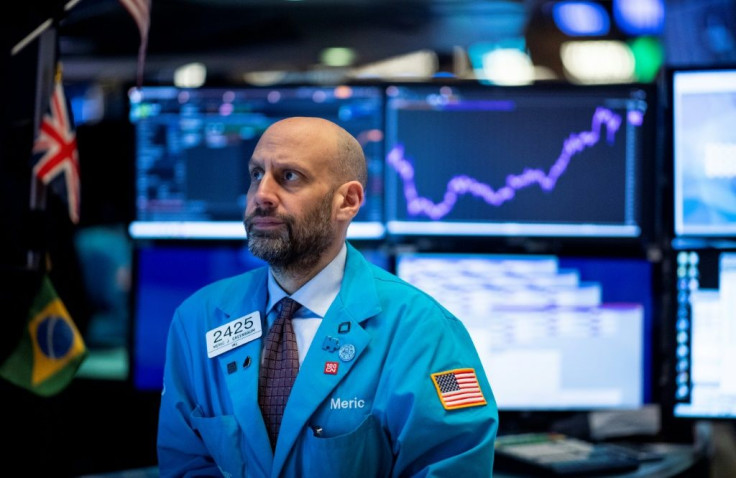Thursday's Stock Market Open: US Equities Open Mixed As Traders Weigh Fed, White House Actions, Oil Rises

KEY POINTS
- Initial jobless claims jumped to 281,000 last week
- The Philadelphia Fed manufacturing index in plunged to minus-12.7 in March
- Trump signed a $100 billion coronavirus relief package bill
Update: 12:05 p.m. EDT:
U.S. stocks were moving higher as of noon Thursday.
The Dow Jones Industrial Average gained 209.08 points to 20,108. while the S&P 500 gained 24.97 points to 2,423.07 and the Nasdaq Composite Index rose 185.67 points to 7,175.51.
The Bank of England has cut interest rates for the second time in a week. The benchmark rate is now 0.1%.
In Europe markets finished higher as Britain’s FTSE-100 gained 1.28%, France’s CAC-40 jumped 1.98% and Germany’s DAX rose 1.81%.
Crude oil futures gained 17.97% at $24.03 per barrel, Brent crude gained 7.32% at $26.70
Update: 10:20 a.m. EDT:
In a wild morning session, U.S. stocks have now turned positive.
The Dow Jones Industrial Average gained 131.13 points to 20,030.05 while the S&P 500 gained 27.26 points to 2,425.36 and the Nasdaq Composite Index rose 210.11 points to 7,199.96.
Update: 9:40 a.m. EDT:
Stocks have turned sharply lower.
The Dow Jones Industrial Average fell 525.82 points to 19,373.10 while the S&P 500 dropped 52.85 points to 2,345.25 and the Nasdaq Composite Index tumbled 69.12 points to 6,920.73.
Original story:
U.S. stocks opened mixed on Thursday as traders assess new fiscal measures by the Federal Reserve and White House.
The Dow Jones Industrial Average fell 83.86 points to 19,815.06 while the S&P 500 slipped 9.28 points to 2,388.82 and the Nasdaq Composite Index gained 16.43 points to 7,006.27.
The Labor Department said Thursday that initial jobless claims jumped by 70,000 to a seasonally adjusted 281,000 last week -- the highest level for since Sept. 2, 2017, when it was 299,000.
The Philadelphia Fed manufacturing index in plunged to minus-12.7 in March from 36.7 in the previous month. The March figure was the lowest reading since June 2012.
On Wednesday, President Donald Trump signed a $100 billion coronavirus relief package bill includes emergency paid leave for workers as well as free testing for coronavirus.
The Trump administration also seeks passage of $1 trillion stimulus measure, which may include direct payments to Americans, tax cuts or relief to industries impacted by virus.
On Wednesday evening, the Federal Reserve introduced the new Money Market Mutual Liquidity Fund which will provide loans to financial institutions to purchase assets from prime money market funds.
The European Central Bank unveiled a new €750 billion ($819 billion) Pandemic Emergency Purchase Program that will buy securities to bolster the European economy. These purchases will be made until the end of 2020.
“The ECB will ensure that all sectors of the economy can benefit from supportive financing conditions that enable them to absorb this shock,” the central bank said. “This applies equally to families, firms, banks, and governments.”
The New York Stock Exchange will temporarily close its historic trading floor and switch fully to electronic trading starting Monday, after two people tested positive for the virus.
“Markets are clearly in a state of panic and forced liquidations – but risks remain skewed to the upside and this should become much more apparent once some of the solvency issues are addressed,” said Adam Crisafulli, founder of Vital Knowledge.
Overnight in Asia, markets fell. China’s Shanghai Composite slipped 0.98%, while Hong Kong’s Hang Seng plunged 2.61%, and Japan’s Nikkei-225 dropped 1.04%.
In Europe markets were lower as Britain’s FTSE-100 fell 1.43%, France’s CAC-40 slipped 0.06% and Germany’s DAX slumped 0.96%.
Crude oil futures gained 10.51% at $22.51 per barrel, Brent crude gained 4.58% at $26.02. Gold futures gained 2.5%.
The euro dropped 1.14% at $1.0792 while the pound sterling fell 0.09% at $1.604.
© Copyright IBTimes 2024. All rights reserved.




















